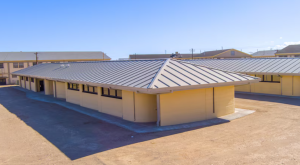Florida Construction New staff writer
The Army and Navy are exploring cutting-edge construction techniques, including 3D printing and mass timber, as potential solutions for building more cost-effective and resilient military barracks and facilities.
These innovative methods could revolutionize how the military approaches infrastructure development in the future.
During a discussion on Capitol Hill today, Dave Morrow, director of military programs for the Army Corps of Engineers (USACE), and Keith Hamilton, chief engineer for Naval Facilities Engineering Systems Command (NAVFAC), briefed lawmakers from the House Appropriations Committee’s Defense Subcommittee on the use of emerging technologies in military construction.
The discussion covered a range of advanced construction techniques, including additive construction (3D printing), high-performance cement, geosynthetics, mass timber (cross-laminated timber or CLT), composite materials, industrialized construction, tension fabric structures, and carbon fiber reinforced polymers. The goal is to find the most cost-efficient, sustainable, and resilient solutions to meet the military’s infrastructure needs while ensuring taxpayer dollars are used wisely.
“In an increasingly complex global security environment, our commitment to innovation in military construction is not just about building structures—it’s about building the resilience and readiness our forces need to prevail,” Morrow explained. “By collaborating with industry to leverage these advancements, we can provide durable, sustainable, and cost-effective facilities for our military.”
The Army Corps of Engineers has already conducted pilot projects using 3D printing technology. Notably, barracks have been constructed at Tyndall Air Force Base in Florida and Fort Bliss in Texas. According to Morrow, additive construction has the potential to reduce costs, manpower, logistics, and construction time, while also enabling new applications in unconventional military operations.
Morrow also highlighted the development of unified facilities criteria, which allow for additive construction in 80% of the United States. This technical standard ensures that 3D-printed structures meet the necessary codes for compliance and usability.
The Navy, meanwhile, is piloting mass timber construction in Hampton Roads, Virginia, where a new child development center is being built with a hybrid mass timber exterior. Mass timber, known for its sustainability and strength, is gaining traction as an alternative to traditional building materials like steel and concrete. Hamilton noted that the Department of Defense (DOD) has embraced cross-laminated timber (CLT), even creating a guide specification for its use.
“As the CLT industry matures, it could become more competitive and could be utilized more widely in DOD construction,” Hamilton said, pointing to a recent initiative where the Army designed its first barracks incorporating mass timber structural elements. He mentioned that such projects might also reduce construction timelines significantly
At Marine Corps Air Station Cherry Point, North Carolina, NAVFAC has also piloted high-performance concrete (HPC) for building a new F-35 Lightning II hangar. HPC is noted for its durability, strength, and resistance to extreme environmental conditions, along with improved thermal and acoustic properties.
“NAVFAC is actively testing and employing innovative technologies, materials, and methods to improve the design and construction of military facilities,” Hamilton said. “We are collaborating with industry, academia, and other government partners to identify and leverage future opportunities.”
To encourage the adoption of alternative construction methods, the Navy now requires planners and engineers to evaluate whether new military construction projects can utilize these innovative techniques to meet mission requirements, lower costs, and accelerate project delivery.
As the Army and Navy continue to experiment with these promising technologies, the potential for 3D printing and mass timber to reshape military construction is becoming increasingly evident. These advancements could provide the armed forces with more flexible, cost-effective, and sustainable solutions to meet their growing infrastructure needs.

